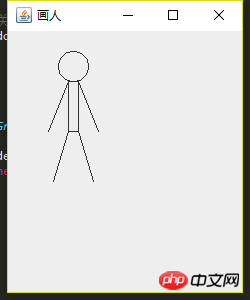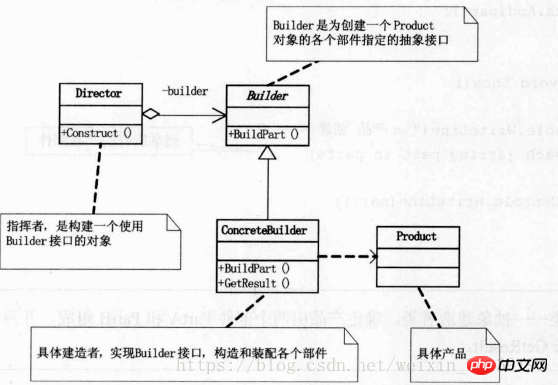Java design patterns-Builder pattern
This article mainly introduces the usage of Builder. Share it with everyone for your reference. The details are as follows:
I was looking at the source code of Mybatis recently, and in the process of reading and parsing the XML configuration file, I found that the builder mode was used. Therefore, I plan to review this design pattern.
Origin
Suppose we need to draw a little person, we may have the following constructor definition:
public Person(HeadType headType, HairType hairType, HairColor hairColor, FaceType faceType, BodyType bodyType, ArmType amrType, LegType legTyype) {
}Seeing such a constructor, we estimate that we will come back later I was confused when I saw it. There are so many parameters, which makes subsequent maintenance very troublesome for us.
The construction pattern can solve such problems.
Use
The goal is to draw a little person
1. Define the abstract Builder
First define the abstract PersonBuilder . This class defines the steps required to draw a villain, so that each object generated through PersonBuilder is essentially the same, but can have different personalities.
abstract class PersonBuilder {
protected Graphics graphics;
public PersonBuilder(Graphics graphics) {
this.graphics = graphics;
}
public abstract void buildHead();
public abstract void buildBody();
public abstract void buildArmLeft();
public abstract void buildArmRight();
public abstract void buildLegLeft();
public abstract void buildLegRight();
}2. Define a specific Builder class
and define a specific implementation class PersonFatBuilder. This class inherits PersonBuilder and implements abstract methods.
public class PersonFatBuilder extends PersonBuilder {
public PersonFatBuilder(Graphics graphics) {
super(graphics);
}
@Override
public void buildHead() {
graphics.drawOval(50, 20, 30, 30);
graphics.drawArc(50, 30, 10, 5, 45, 135);
graphics.drawArc(70, 30, 10, 5, 45, 135);
graphics.drawArc(60, 35, 10, 5, 200, 135);
}
@Override
public void buildBody() {
graphics.drawRect(55, 50, 20, 50);
}
@Override
public void buildArmLeft() {
graphics.drawLine(55, 50, 40, 100);
}
@Override
public void buildArmRight() {
graphics.drawLine(75, 50, 90, 100);
}
@Override
public void buildLegLeft() {
graphics.drawLine(55, 100, 45, 150);
}
@Override
public void buildLegRight() {
graphics.drawLine(75, 100, 85, 150);
}
}3. Define the specific Director class
This class is responsible for the specific construction process and does not care about what is built.
public class PersonDirector {
private PersonBuilder personBuilder;
public PersonDirector(PersonBuilder personBuilder) {
this.personBuilder = personBuilder;
}
public void drawPerson() {
personBuilder.buildHead();
personBuilder.buildBody();
personBuilder.buildArmLeft();
personBuilder.buildArmRight();
personBuilder.buildLegLeft();
personBuilder.buildLegRight();
}
}4. Test
Create a window and draw the villain.
public static void main(String[] args) {
EventQueue.invokeLater(new Runnable() {
@Override
public void run() {
// 创建窗口对象
JFrame frame = new JFrame();
frame.setVisible(true);
frame.setTitle("画人");
frame.setSize(250, 300);
// 设置窗口关闭按钮的默认操作(点击关闭时退出进程)
frame.setDefaultCloseOperation(WindowConstants.EXIT_ON_CLOSE);
// 把窗口位置设置到屏幕的中心
frame.setLocationRelativeTo(null);
frame.setContentPane(new JPanel(){
@Override
protected void paintComponent(Graphics g) {
super.paintComponent(g);
PersonThinBuilder thinBuilder = new PersonThinBuilder(g);
PersonDirector director = new PersonDirector(thinBuilder);
director.drawPerson();
}
});
}
});
}The results are as follows:

Definition
Literal definition
Compare the construction of complex objects with it Separation of representations allows the same construction process to create different representations.
In other words, it allows you to create different types of objects while avoiding pollution of the constructor. This pattern is useful when there are multiple types of objects. Or there are many steps involved in creating an object.
Structural diagram
Quoting a diagram from "Dahua Design Pattern"

Builder: Create ProductObject and abstract interface.
ConcreateBuilder: Specific builder, constructs and assembles various components.
Product: The object we need to build.
Director: Used to create products, it has member variables of type Builder inside.
- ##Director
No need to know the internal details of
Product, it only provides the required information to the builder, It is processed by the specific builderConcreateBuilderto complete the construction of the product. The builder pattern disperses the complex product creation process into different objects, thereby achieving more precise control over the product creation process and making the creation process clearer. - Each specific builder can create a complete product object, and it is independent of each other. Therefore, the caller can get different objects through different concrete builders. When a new product appears, there is no need to change the original code, just add a builder.
- Example
Now if we want to build a fat little man with facial features. Then we only need to add a
PersonFatBuilder class, and there is no need to change the original code. The above is the detailed content of Java design patterns-Builder pattern. For more information, please follow other related articles on the PHP Chinese website!public class PersonFatBuilder extends PersonBuilder {
public PersonFatBuilder(Graphics graphics) {
super(graphics);
}
@Override
public void buildHead() {
graphics.drawOval(50, 20, 30, 30);
graphics.drawArc(50, 30, 10, 5, 45, 135);
graphics.drawArc(70, 30, 10, 5, 45, 135);
graphics.drawArc(60, 35, 10, 5, 200, 135);
}
@Override
public void buildBody() {
graphics.drawRect(55, 50, 20, 50);
}
@Override
public void buildArmLeft() {
graphics.drawLine(55, 50, 40, 100);
}
@Override
public void buildArmRight() {
graphics.drawLine(75, 50, 90, 100);
}
@Override
public void buildLegLeft() {
graphics.drawLine(55, 100, 45, 150);
}
@Override
public void buildLegRight() {
graphics.drawLine(75, 100, 85, 150);
}
} Related recommendations:
Related recommendations:

Hot AI Tools

Undresser.AI Undress
AI-powered app for creating realistic nude photos

AI Clothes Remover
Online AI tool for removing clothes from photos.

Undress AI Tool
Undress images for free

Clothoff.io
AI clothes remover

Video Face Swap
Swap faces in any video effortlessly with our completely free AI face swap tool!

Hot Article

Hot Tools

Notepad++7.3.1
Easy-to-use and free code editor

SublimeText3 Chinese version
Chinese version, very easy to use

Zend Studio 13.0.1
Powerful PHP integrated development environment

Dreamweaver CS6
Visual web development tools

SublimeText3 Mac version
God-level code editing software (SublimeText3)

Hot Topics
 1386
1386
 52
52
 Perfect Number in Java
Aug 30, 2024 pm 04:28 PM
Perfect Number in Java
Aug 30, 2024 pm 04:28 PM
Guide to Perfect Number in Java. Here we discuss the Definition, How to check Perfect number in Java?, examples with code implementation.
 Weka in Java
Aug 30, 2024 pm 04:28 PM
Weka in Java
Aug 30, 2024 pm 04:28 PM
Guide to Weka in Java. Here we discuss the Introduction, how to use weka java, the type of platform, and advantages with examples.
 Smith Number in Java
Aug 30, 2024 pm 04:28 PM
Smith Number in Java
Aug 30, 2024 pm 04:28 PM
Guide to Smith Number in Java. Here we discuss the Definition, How to check smith number in Java? example with code implementation.
 Java Spring Interview Questions
Aug 30, 2024 pm 04:29 PM
Java Spring Interview Questions
Aug 30, 2024 pm 04:29 PM
In this article, we have kept the most asked Java Spring Interview Questions with their detailed answers. So that you can crack the interview.
 Break or return from Java 8 stream forEach?
Feb 07, 2025 pm 12:09 PM
Break or return from Java 8 stream forEach?
Feb 07, 2025 pm 12:09 PM
Java 8 introduces the Stream API, providing a powerful and expressive way to process data collections. However, a common question when using Stream is: How to break or return from a forEach operation? Traditional loops allow for early interruption or return, but Stream's forEach method does not directly support this method. This article will explain the reasons and explore alternative methods for implementing premature termination in Stream processing systems. Further reading: Java Stream API improvements Understand Stream forEach The forEach method is a terminal operation that performs one operation on each element in the Stream. Its design intention is
 TimeStamp to Date in Java
Aug 30, 2024 pm 04:28 PM
TimeStamp to Date in Java
Aug 30, 2024 pm 04:28 PM
Guide to TimeStamp to Date in Java. Here we also discuss the introduction and how to convert timestamp to date in java along with examples.
 Java Program to Find the Volume of Capsule
Feb 07, 2025 am 11:37 AM
Java Program to Find the Volume of Capsule
Feb 07, 2025 am 11:37 AM
Capsules are three-dimensional geometric figures, composed of a cylinder and a hemisphere at both ends. The volume of the capsule can be calculated by adding the volume of the cylinder and the volume of the hemisphere at both ends. This tutorial will discuss how to calculate the volume of a given capsule in Java using different methods. Capsule volume formula The formula for capsule volume is as follows: Capsule volume = Cylindrical volume Volume Two hemisphere volume in, r: The radius of the hemisphere. h: The height of the cylinder (excluding the hemisphere). Example 1 enter Radius = 5 units Height = 10 units Output Volume = 1570.8 cubic units explain Calculate volume using formula: Volume = π × r2 × h (4
 Create the Future: Java Programming for Absolute Beginners
Oct 13, 2024 pm 01:32 PM
Create the Future: Java Programming for Absolute Beginners
Oct 13, 2024 pm 01:32 PM
Java is a popular programming language that can be learned by both beginners and experienced developers. This tutorial starts with basic concepts and progresses through advanced topics. After installing the Java Development Kit, you can practice programming by creating a simple "Hello, World!" program. After you understand the code, use the command prompt to compile and run the program, and "Hello, World!" will be output on the console. Learning Java starts your programming journey, and as your mastery deepens, you can create more complex applications.




